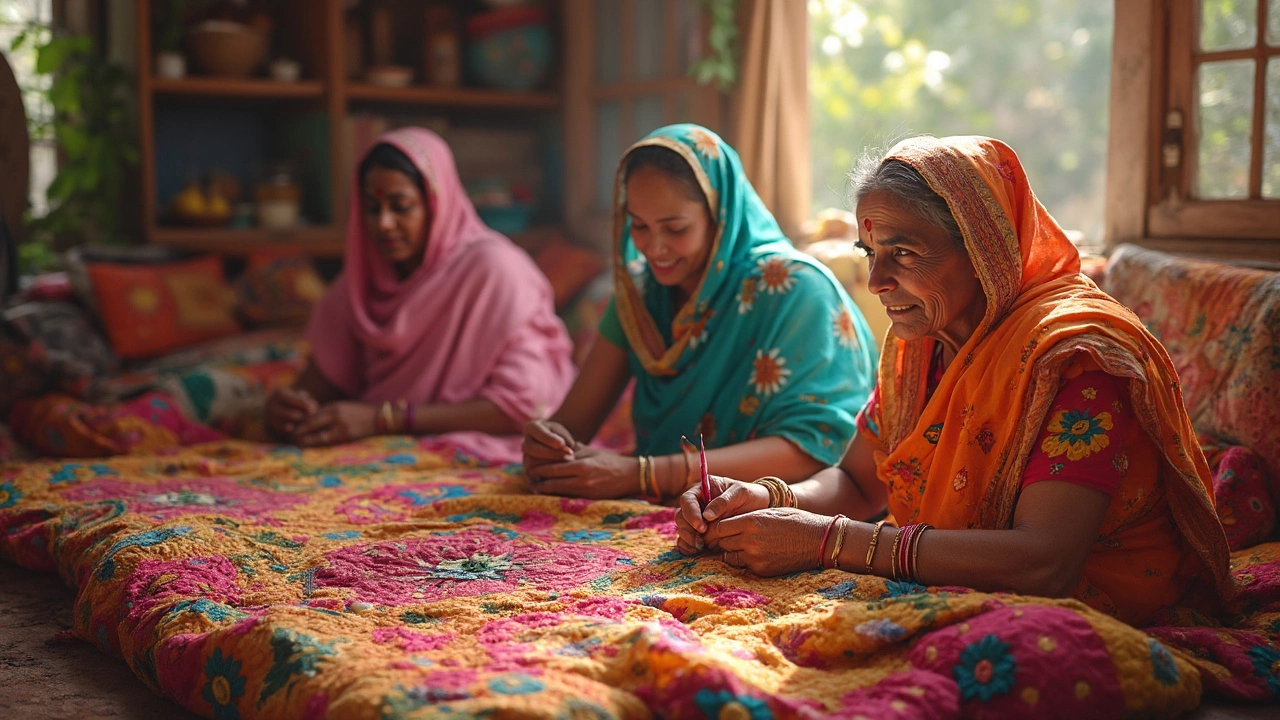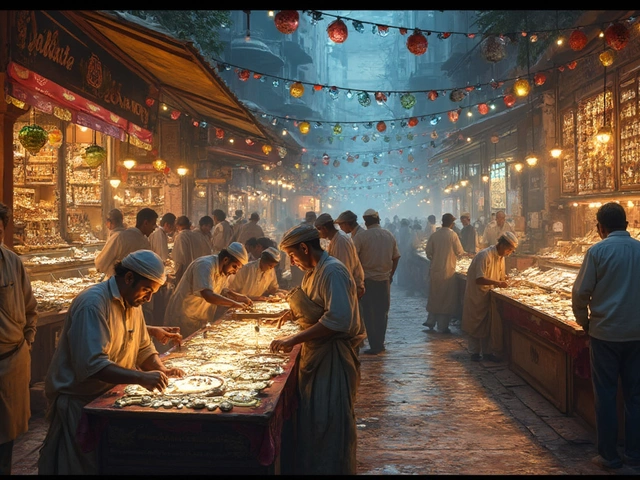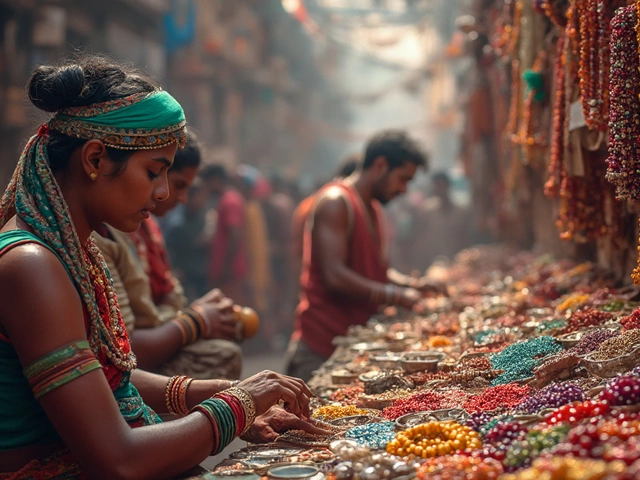
Kantha isn’t some random fabric off the shelf. It’s one of the coolest mashups of recycling, art, and tradition from India. Picture this: old cotton saris and dhotis, layered and held together with rows of small, straight stitches. That’s kantha for you—usually a soft cotton base, stacked up and slow-stitched into colorful quilts, throws, or even jackets. No high-tech factories. Just sharp needles, nimble fingers, and tons of patience.
If you’ve seen those swirly, wavy patterns on a quilt at someone’s place or at a temple jewellery stall, that’s probably kantha work. It’s ultra-comfortable too—cotton keeps it breezy, and the hand-stitching means every piece has its own vibe. This isn’t just old-school recycling; it’s wearable history.
- What Exactly Is Kantha?
- The Fabric Canvas: Cotton and Beyond
- How Kantha Is Made: The Hands Behind the Art
- Kantha in Temple Jewellery and Indian Fashion
- Spotting Authentic Kantha: Quick Tips
- Caring for Your Kantha Pieces
What Exactly Is Kantha?
If you ask anyone in Bengal or Bangladesh what kantha fabric is, they'll probably show you a worn-out sari that's been turned into a vibrant throw or quilt, loaded with lines of tiny running stitches. Kantha is basically the art of taking old cotton cloth—think saris and dhotis—and layering them together with hand embroidery. The result? Super soft, lightweight textiles that work as blankets, wraps, or even jackets and accessories.
What sets kantha apart from other indian textiles is that it’s all about reuse and storytelling. Women in the region have been making kantha for hundreds of years, and each piece is different. You’ll see everything from floral designs to animals, geometric shapes, and even little scenes from daily life sewn onto the fabric. If you see rows and rows of what look like tiny dashed lines, you’re looking at that classic kantha stitch.
This isn't a niche hobby, either. Some researchers dig up examples of kantha work going back at least 500 years. These textiles were so popular, they’d even get gifted at weddings or big family events. Today, you’ll find kantha in everything from home decor to designer wear, right alongside temple jewellery and other Indian cultural staples.
Most original kantha pieces used old cotton for the base, though now there’s experimentation with silk and linen. But cotton is where this tradition began and still dominates for its comfort and breathability. When you spot a real kantha item, it won’t look machine-made. The handwork—the slightly uneven, visible running stitches—is what makes each piece unique and valuable.
The Fabric Canvas: Cotton and Beyond
Cotton is the backbone of kantha fabric. Traditionally, makers picked up worn-out cotton saris, dhotis, or lungis—basically clothes that had seen better days—and stacked them to create a fresh, thicker canvas. Why cotton? Because it’s soft, easy to layer, and takes well to all those tiny, running stitches that define kantha. Cotton also keeps things cool in the heat, so you can actually use a kantha quilt during a sultry Indian summer and not feel stifled.
Kolkata and West Bengal are famous hotspots for this craft, but kantha isn’t just stuck to one state or fiber. Over the past decade, kantha has started surfacing on other fabrics too. Makers experiment with hand embroidery on silk, tussar (a type of raw silk), georgette, linen, and even blends. Silk kantha scarves, for example, look pretty trendy and work as both fashion statements and wedding gifts.
If you ever wondered what’s common among all these versions, here’s the simple answer: the technique. Whether it’s on an upcycled sari or a brand-new silk shawl, the rows of hand stitches and patchwork style are the DNA of kantha.
Here’s a quick look at which fabrics show up most often in kantha work:
- Cotton – Classic, cool, and easy to stitch; the OG base for most kantha items.
- Silk – Gives a richer look and a smoother finish, perfect for shawls and stoles.
- Linen – Adds a bit of texture and stands up to daily use.
- Tussar or raw silk – Rustic sheen, used a lot in Bengal kantha sarees and dupattas.
- Blends – Sometimes you’ll see a mix for extra durability or a twist in appearance.
Most stores still sell cotton kantha the most—according to a 2023 artisan collective survey, about 67% of kantha products used all-cotton layers, while silk and other fibers made up the rest.
| Fabric Type | Popularity (%) |
|---|---|
| Cotton | 67 |
| Silk / Tussar | 21 |
| Linen & Blends | 12 |
So if you’re picking a kantha piece for yourself or matching something flashy with your temple jewellery, check what’s underneath the stitches. The fabric really changes the feel—and the story—of what you’re wearing.
How Kantha Is Made: The Hands Behind the Art
Making kantha fabric isn’t about fancy machines or huge factories. It’s straight-up handwork, typically done by women in rural Bengal and Odisha. Most kantha starts out as a pile of old cotton saris or dhotis. Nothing goes to waste. Artisans layer these worn pieces, matching patterns or colors they like, and hold the stack together with pins.
The magic kicks in with the stitching. Using regular cotton thread, each artisan sews hundreds—sometimes thousands—of tiny running stitches, creating funky patterns, spirals, or even scenes from daily life. There’s no rush. One decent-sized kantha quilt (they call it a ‘nakshi kantha’) can take weeks or even months to finish, depending on size and the stitch detail.
- Step 1: Select old cotton saris or dhotis—nothing synthetic
- Step 2: Layer them up for the desired thickness (usually 2-5 layers)
- Step 3: Pin the layers and start running stitches by hand, following a pattern or improvising as you go
- Step 4: Add border details—these often have the densest stitching
- Step 5: Finish with another inspection for missed spots or loose threads
The best part? Every piece is one of a kind. No two kantha patches look the same, because no two hands stitch exactly alike. You’d be surprised to know that over 90% of kantha artisans work from their own homes or small local groups, not big workshops. That’s real grassroots craftsmanship for you.

Kantha in Temple Jewellery and Indian Fashion
When you talk about Indian style, kantha fabric is right there with temple jewellery—both loaded with history and identity. Kantha came out of Bengal and Odisha, but its colourful, textured vibe soon caught on everywhere. You’ll spot it as dupattas, sarees, even scarves paired with traditional gold jewellery, especially the chunky, goddess-inspired pieces locals call temple jewellery.
Why does this combo work so well? Simple: kantha is all about detailed hand work and so is temple jewellery. The bold, gold pieces with goddess motifs actually look better paired with soft, lightly quilted kantha wraps instead of flashy fabrics. It’s style, but there’s also meaning—it’s showing off the skill of Indian handiwork, not mass-produced stuff from some random catalog.
Modern Indian designers aren’t missing the point here. Labels in Kolkata and across southern India have put kantha fabric into everything from sarees to long jackets meant to go with temple jewellery. People wear these sets for weddings, festivals like Durga Puja, even as everyday ethnic wear. There’s this whole trend of mixing heritage looks with comfy kantha, so you’re not sacrificing practicality for tradition.
Here’s a quick rundown of where you’re likely to see kantha in the world of Indian fashion and temple jewellery:
- Wedding ensembles: Brides pick kantha sarees with antique temple jewellery for that old-meets-new vibe.
- Festivals: During major events, women often wear kantha shawls or blouses with heavy gold temple necklaces.
- Everyday: Lighter kantha stoles are pretty popular over simple kurtas, with a gold pendant tossed in to finish the look.
And believe it or not, kantha items are gaining ground in export markets. According to a 2023 report, handmade kantha exports from India hit around $40 million, with the US and UK buying up a big chunk of the stock—often as part of accessory and jewellery pairings.
Spotting Authentic Kantha: Quick Tips
So you’re eyeing a kantha quilt or a cool embroidered jacket and want to make sure it’s the real deal? Here’s how you can tell if it’s authentic kantha fabric, not something mass-produced in a factory.
- Check the Stitching: Real kantha uses tiny, uneven, running stitches—nothing too perfect. Hand-stitched means the threads may not be exactly even, and you can actually see the start and end knots in places.
- Feel the Fabric: Original kantha is almost always made on old cotton. If the fabric feels too stiff or synthetic, it’s probably not traditional. Cotton is soft, breathable, and wears in really well over time.
- Flip It Over: The back of an authentic kantha piece should show the stitching just as clearly as the front. You might notice loose thread tails or color changes—that’s a sign of handwork, not a sign of bad quality.
- Look for Patchwork: Especially with quilts and throws, traditional kantha is about upcycling. You’ll often see bits of different colored sari fabric pieced together, with the embroidery stitching holding the layers down.
- Spot the Imperfections: Mass-produced stuff looks perfect. Real kantha is full of small quirks and differences in the stitch size and flow.
If you’re at a market or store, ask about where the piece was made. Shops that know their stuff can usually tell you which region or artisan group made your kantha. Pieces from West Bengal and Bangladesh are especially prized for tradition and quality. Here’s what a textile expert I admire says:
“Genuine kantha carries with it the slight ‘imperfection’ of the artisan’s hand—each piece feels alive and distinctly human.” — Ritu Kumar, Indian fashion designer
You can even use your phone for a quick check. Hold your kantha up to light; real hand-stitched layers might let a bit of light shine through because of the thin cotton and loose stitching, while machine work blocks out almost all the light. And if it feels lightweight and a bit floppy, you’ve probably got traditional cotton kantha fabric in your hands.
| Feature | Handmade Kantha | Machine-made Lookalike |
|---|---|---|
| Stitching | Irregular, knots visible | Even, perfect lines |
| Fabric Type | Soft old cotton | Stiff, synthetic or brand new |
| Patchwork | Often visible | Rarely present |
| Finish | Quirky, imperfect | Uniform, flawless |
One more thing: beware of rock-bottom prices. If someone offers kantha way cheaper than everywhere else, it’s probably just a print or machine-sewn copy and not true handmade kantha fabric.
Caring for Your Kantha Pieces
If you want your kantha fabric to stick around and keep looking great, there are some smart moves you can make. Unlike mass-produced quilts, each kantha piece is loaded with delicate, hand-done stitches, usually with soft cotton that soaks up color and holds onto scents (sometimes, that new-fabric smell lingers for a bit!). Taking care of these isn’t rocket science, but you do have to be a bit gentle.
First off, go easy with the washing. If your kantha is mostly cotton—and nearly all authentic pieces are—hand washing is safer than tossing it in a machine. Cold water is your best friend. Warm or hot water can shrink the fabric or mess with the colored threads. Mild, non-bleach soap is another must-have; harsh detergents can weaken those iconic stitches. Rinse it out and then lay it flat to dry, preferably out of direct sunlight. Hanging can stretch the fabric out, and sun can fade the colors faster than you’d expect.
- Spot clean stains with a soft cloth instead of scrubbing, which can pull threads loose.
- If you absolutely need to use a washing machine, use the gentlest cycle in a mesh bag. Skip the tumble dry—air drying really is worth the extra effort.
- Store your kantha in a dry, cool place. Never seal it in a plastic bag; cotton needs to breathe or you’ll get mildew spots fast.
- If you want to iron it, keep it inside-out and on low heat. Too much heat can damage the embroidery.
Bonus tip: If you wear kantha as a jacket or shirt, try not to wear it with jewelry that snags easily. Those famous hand stitches on your clothing are strong, but they’re not invincible. And if you ever spot a loose thread, don’t yank it—just tie a small knot to keep the rest of the stitching in place.
| Care Aspect | Best Practice | Common Mistake |
|---|---|---|
| Washing | Hand wash cold with mild soap | Hot wash or bleach |
| Drying | Air dry flat, out of sun | Use dryer or hang in sun |
| Storage | Store in breathable bag | Plastic bag storage |
Follow these tips, and your kantha will stay vibrant and sturdy for years. Treat it right, and it’s basically a lifetime piece—just like classic temple jewellery that gets passed down through the family.



